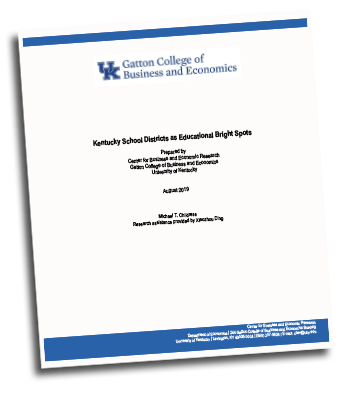MAKING PROFICIENCY A DISTRICT CONSTANT

FEBRUARY 2020 \ MONROE COUNTYA clear handle on fractions is the goal for fourth-grade math students one January morning at Gamaliel Elementary, a small school perched near the Tennessee border in Monroe County. Teacher Shelly Buck asks her students to concentrate and visualize: “Make up one-fourth in your head,” she says. “If you were to visually picture one-fourth, is it more or less than one half?” She asks students to think and be prepared to take a position or to agree or disagree with classmates who volunteer an answer.When it comes to math, schools across Monroe County routinely turn numbers into concepts before they plow through problems with paper and pencil. This same morning, across the county at Joe Harrison Carter Elementary, fourth graders are covering almost the same math standard. Their teacher, Shelly Scott, has handed out small colored tiles allowing students to line up equivalent fractions on their desks.Students here know their teachers will find several approaches to important math concepts.“They teach math in different ways,” explained Gamaliel fifth-grader Aurora Logan, 10. She said the various perspectives help. “If we don’t understand, they’ll teach us other ways,” she said. “On fractions, she taught us one way to do it but ended up teaching us a different way that was easier for me.”For the better part of a decade, Monroe County has been focused on not only exposing students to academic standards, but making sure students master important concepts. Schools identify the most essential learning goals for extra emphasis. For all standards, however, all three elementary schools have tailored training, ongoing classroom assessment, data analysis, and student report cards to move toward ensuring that all students meet all standards.As it happens, fractions are a big deal for teachers and administrators, who are constantly aware of moving increasing numbers of students to mastery and proficiency.MONROE COUNTY SCHOOLS Superintendent Amy Thompson, right, listens as fourth-grade teacher Shelly Buck and students at Gamaliel Elementary discuss equivalent fractions. “We know exactly what we’re looking for,” said Tompkinsville Elementary fifth-grade teacher Chelsey Murphy. Teachers design assessments to constantly monitor what students know and determine when to circle back, reinforce, or move ahead. “We don’t get data and put it aside,” Murphy said. “We use it with our kids and think about whether they are missing things because we need to go back over concepts or whether people are making simple math mistakes.”Visits to classrooms and administrators at all three Monroe County elementary schools showed a common approach to knowing how well individual students are meeting expectations and ways that plans are adjusted each week to make sure any weak points are getting extra attention. (The same data monitoring allows students who exceed expectations to tackle more challenging material.)The results jump out. Monroe County was named a “bright spot district” in a statewide analysis of student performance by the Center for Business and Economic Research at the University of Kentucky in partnership with the Prichard Committee for Academic Excellence.The 2019 study, examining state test results from 2012-17, used local socioeconomic data to establish a predicted level of performance. The report identified 12 districts that significantly exceeded those expectations based on overall average test scores in at least one of the years studied. In addition, the study only identified districts where less-advantaged students showed steady progress over the span including a better-than-expected outcome in 2017.Monroe County’s elementary math scores showed unexpectedly high-level performance by students across the district, according to the UK report. The district was the only one in the state to qualify the study’s “bright spot” status over all six years. Both overall scores and performance by students from low-income families exceeded the study’s predicted level. By 2017, the report found that three-fourths of all students reached proficient or better in elementary math, with students from low-income families achieving at the same level.Leaders of the district point to events and connections that go back two decades to explain the strong outcomes. In the 1990s, achievement was mediocre. District officials requested a scholastic audit from the state to better understand where schools were falling short. The results described many shortcomings. Teachers, principals, and district leaders responded by making improvements.“They left us a 100-page document that said, ‘You think you’re teaching the standards, but you’re not,’ ” recalled Christie Biggerstaff, a Gamaliel elementary teacher at the time who has since become an elementary principal and is now the district’s instructional supervisor. “We really had a hard time with that because we thought we were.” Biggerstaff remembered that Monroe teachers were working hard but lacked strategies to ensure student understanding and teacher focus.
Student understanding and teacher focus have grown dramatically over a two-decade improvement drive, leaders say.
“At that point we were excuse driven, and we had to get over that” Biggerstaff said. The steps toward improving classroom performance required change, and also showed results. “It forced us to work together on things like curriculum pacing and developing good assessments. We got better and better, and we’ve never looked back. Once you know you’re doing the right things for kids, you never want to let that go.”Other former teachers have risen to building leadership and, some, to district positions, producing a leadership team with first-hand involvement in a 20-year focus on school improvement. The team-building and relationship emphasis that have worked for adults are also a priority in engaging students and families, according to Superintendent Amy Thompson. The 23-year Monroe educator and native rose from special-education teacher to high school assistant principal to middle school principal to central office positions before being tapped as superintendent six years ago.“We focus heavily on creating a relationship with our students, parents, and community. We want students to achieve at the highest levels possible, and we work endlessly to do just that — to remove barriers for kids,” Thompson said. “That leads us to our instructional practices.”Connecting with students is a prerequisite for the learning focus that drives the school routine.“For the first two or three weeks of school, I tell all of our employees to get to know your kids that you have in your classrooms, that are in your hallways, riding your bus, eating lunch in your lunchroom — get to know those children,” Thompson explained. “Know their favorite color, their middle name, their hobby, what they love to read, their favorite subject in school. Let them know that you care about them as a person. If you get to teach some math or reading in the first two or three weeks of school that’s OK, but what I’m really concerned about is that we get to know our kids. If they know that you took time to get to know them, they will knock down walls to learn for you.”From there, Monroe leaders expect teachers combine their knowledge of individual students with an awareness of academic standards, becoming experts on where students stand and a plan to reach school goals.
If (students) know that you took time to get to know them, they will knock down walls to learn for you.
— Amy Thompson, superintendent
“We do hold high expectations,” said Heather Geralds, the Tompkinsville Elementary principal. “We want them to know they can learn. Not every kid likes math, but that doesn’t mean they can’t learn to do well in math.”All three elementary schools plan and train together and regularly administer common assessments to pinpoint individual strengths and needs. Student assignments to intervention time, where previous content can be reviewed or retaught, change weekly depending on teachers’ decisions about pupils’ needs.Schools strive to create an atmosphere where understanding important concepts matters more than making a high grade on the first try. Teachers encourage students to be honest about where they stand, which also helps deliver interventions, said Megan Roper, assistant principal at Gamaliel Elementary. “They’re comfortable asking for help — they’ll say, ‘I don’t get this,’ or ‘I didn’t get it right.’ ”Administrators also monitor which students are in good shape, who is close to the expectation line, and who is behind. With an eye toward the school calendar, they offer input on plans for classes or individual students.Jeff Blythe, principal at Joe Harrison Carter Elementary, described a January data meeting with central office leaders. Looking at current performance, they brainstormed strategies to implement leading to Spring Break. After that, he said, only 30 instructional days remain to close gaps or work with students to help them move forward. “The good thing,” he said, “is that every year at this time is when their performance starts jumping.”Kynley Gee, a fifth grader at Carter Elementary, said that the combination of different approaches to math (“the rotations and hands-on really help”), the supportive drive of teachers (“they make it feel like home”) and encouragement to have a growth mindset (“I thought I couldn’t at first, but now I know I can”) have combined to make her a confident math student.Fifth graders at Tompkinsville Elementary express a similar sentiment:“Knowing my teacher is there to help every step of the way, I’ve gone from a zero to a 7 or 8 ,” explained Bree-Ann McClendon, 10.“The different techniques they give will show us how to remember everything,” added Eli Davis, 10. “The teachers teach us real well.”SHELLY SCOTT, A FOURTH-GRADE teacher at Joe Harrison Carter Elementary in Monroe County, describes equivalent fractions with students in her class. TOP PHOTO: Students in Scott’s class use fraction tiles to practice concepts and discuss math ideas.

USING DATA TO FIND BRIGHT SPOTS DISTRICTS
Last August, the Center for Business and Economic Research at the University of Kentucky examined statewide student test results and local socioeconomic factors in search of “better than expected” district-level performance. The report was designed to identify school districts worthy of a closer look. Results highlighted proficiency by all students, high achievement by students who qualified for free- or reduced-price meals, and improved performance over a six-year period. The study found 12 “exemplar” districts.

“Since school districts are likely to reflect the underlying economic conditions of their surrounding communities, the socioeconomic characteristics of Kentucky’s school districts are as diverse as the state itself,” the report found. “This is evidenced by the percentages of less‐advantaged students in the Oldham and Owsley County School Districts, which are, respectively, 22 and 89 percent. Likewise, the average per-pupil expenditures in the top quartile of districts is one‐third higher than those in the bottom quartile — $13,380 compared to $10,140.”The report, produced in partnership with the Prichard Committee for Academic Excellence, is “best viewed as a statistical sieve designed to narrow the list of candidate districts worthy of closer examination,” it noted.Several districts highlighted in the report will be profiled in this on-going Bright Spots blog. The blog provides a classroom-level view of promising practices and trends in student learning across Kentucky.The visit to Monroe County showed a district that re-examined its approaches to students, teaching and learning and implemented a cycle of ongoing improvement that still continues. The district has incorporated many strategies commonly used in Kentucky schools, but tailored them to meet its own view of student needs and priorities for identifying and addressing student progress.In Monroe County, several priorities emerged:\ Prioritizing relationships with students, families, and among district staff are essential to maximizing performance;\ Building teachers’ and administrators’ capacity to use and discuss data fuels strategic conversations and decisions;\ Seeing mastery of standards as the ultimate classroom goal, driving approaches to assessment, interventions, and how teachers create learning experiences.\ Cultivating teacher expertise within and across schools to provide classroom-level coaching, deliver relevant professional development and grow future leaders.Each month, the BRIGHT SPOTS blog showcases impressive learning in Kentucky schools.READ OTHER STORIES IN OUR SERIES ON DISTRICTS IDENTIFIED IN UK’S ‘BRIGHT SPOTS’ REPORT\ A RENEWED APPROACHat Robertson County\ AN ONGOING CHALLENGE at Jenkins IndependentABOUT MONROE COUNTY ELEMENTARY SCHOOLS \ENROLLMENT: 820 at three P-5 schools — Gamaliel Elementary, Joe Harrison Carter Elementary, and Tompkinsville ElementaryKEY DEMOGRAPHICSRACE: 12.2% minority across all elementary schoolsINCOME: 71.1% eligible for free/reduced price meals across all three schoolsDATA NOTES\ On 2019 K-PREP state tests, Monroe County far outpaced state averages and showed minimal achievement gaps based on family economic status. On the state reading test, 84.8 percent of Monroe County elementary students considered non-economically disadvantaged scored proficient or better. Among Monroe students whose family income qualified for free- or reduced-price meals, 82.7 percent scored proficient or better. (For comparison, the state’s proficient-or-better level for non-economically disadvantaged elementary students was 69.8 percent. For students who qualified for reduced-price meals, the rate was 45.8 percent.)In math, 75.1 percent of Monroe County students labeled economically disadvantaged scored proficient or better, more than double the state rate of 35.6 percent. Meanwhile, 82.8 percent of non-economically disadvantaged Monroe students reached proficient status. The state rate for that group was 63.1 percent.\ Monroe County boasts two of the 37 elementary schools statewide that reached five-star status in the first year of the state’s new school accountability system — Tompkinsville and Gamaliel.\ Gamaliel Elementary was recognized in 2018 as a National ESEA Distinguished School for its record of reducing achievement gaps. (ESEA is the flagship federal program supporting public schools.) In 2019, Gamaliel accomplished the rare feat of seeing students who qualified for free- or reduced-price meals (three-fourths of the school’s population) outperform peers. On the state math test, 83.9 percent of students considered economically disadvantaged scored proficient or better while 83.3 percent of non-economically disadvantaged students reached or exceeded proficient status. In reading, 85.1 percent of economically disadvantaged students hit the proficient bar compared to 83.3 percent of non-economically disadvantaged pupils.




